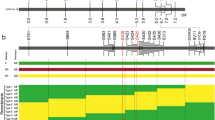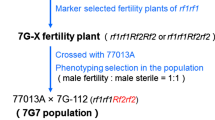Abstract
Cytoplasmic male sterility (CMS), an economically important trait for hybrid seed production in many crops, is a maternally inherited trait in which a plant fails to produce functional anthers, pollen grains, or male gametes. It has long been reported that the restoration of CMS in chili pepper is controlled by a major nuclear gene termed restorer-of-fertility (Rf), along with several modifiers and some environmental factors. In this study, we identified the partial restoration (pr) locus related to the fertility restoration of CMS, demonstrated the inheritance of the trait, and developed a CAPS marker closely linked to the locus. The partially restored plant had normal anthers that produced a mix of normal and aborted pollen grains that stuck tightly to the anther wall, even after dehiscence. This trait was expressed only when the pepper plant had the sterile (S) cytoplasm and homozygous recessive pr alleles. A total of 768 AFLP primer combinations were screened, and bulked segregant analysis (BSA) was performed by preparing two pools of eight Pr/Pr (fully fertile) and eight pr/pr (partially fertile) plants, respectively, selected from the 87 individuals of the F2 segregating population. Of the eight Pr-linked AFLP markers that were identified, E-AGC/M-GCA122 and E-TCT/M-CCG116 were the closest to the locus, estimated at about 1.8 cM in genetic distance. E-AGC/M-GCA122 was converted into a CAPS marker, PR-CAPS, based on the sequences of the internal and flanking regions of the AFLP fragment. This PR-CAPS marker could be useful in selecting fully fertile lines (Pr/Pr) and eliminating partially fertile (pr/pr) and potential (Pr/pr) lines in segregant populations during the development of new inbred restorer lines.




Similar content being viewed by others
References
Akagi H, Nakamura A, Yokozeki-Misono Y, Inagaki A, Takahashi H, Mori K, Fujimura T (2004) Positional cloning of the rice Rf-1 gene, a restorer of BT-type cytoplasmic male sterility that encodes a mitochondria-targeting PPR protein. Theor Appl Genet 108:1449–1457
Bentolila S, Alfonso AA, Hanson MR (2002) A pentatricopeptide repeat-containing gene restores fertility to cytoplasmic male-sterile plants. Proc Natl Acad Sci USA 99:10887–10892
Brown GG, Formanova N, Jin H, Wargachuk R, Dendy C, Patil P, Laforest M, Zhang J, Cheung WY, Landry BS (2003) The radish Rfo restorer gene of Ogura cytoplasmic male sterility encodes a protein with multiple pentatricopeptide repeats. Plant J 35:262–272
Desloire S, Gherbi H, Laloui W, Marhadour S, Clouet V, Cattolico L, Falentin C, Giancola S, Renard M, Budar F, Small I, Caboche M, Delourme R, Bendahmane A (2003) Identification of the fertility restoration locus, Rfo, in radish, as a member of the pentatricopeptide-repeat protein family. EMBO Rep 4:588–594
Duvick DN (1959) The use of cytoplasmic male-sterility in hybrid seed production. Econ Bot 13:167–195
Gulyas G, Pakozdi K, Lee JS, Hirata Y (2006) Analysis of fertility restoration by using cytoplasmic male-sterile red pepper (Capsicum annuum L.) lines. Breed Sci 56:331–334
Hanson MR, Bentolila S (2004) Interactions of mitochondrial and nuclear genes that affect male gametophyte development. Plant Cell 16:S154–S169
Hanson MR (1991) Plant mitochondrial mutations and male sterility. Annu Rev Genet 25:461–486
Horner HT Jr, Rogers MA (1974) A comparative light and electron microscopic study of microsporogenesis in male-fertile and cytoplasmic male-sterile pepper (Capsicum annuum). Can J Bot 52:435–441
Kaul MLH (1988) Male sterility in higher plants. Springer-Verlag, Berlin
Kazama T, Toriyama K (2003) A pentatricopeptide repeat-containing gene that promotes the processing of aberrant atp6 RNA of cytoplasmic male-sterile rice. FEBS Lett 544:99–102
Kim DH, Kang JG, Kim S, Kim BD (2001) Identification of coxII and atp6 regions as associated to CMS in Capsicum annuum by using RFLP and long accurate PCR. J Kor Soc Hort Sci 42:121–127
Kim DH, Kim BD (2005) Development of SCAR markers for early identification of cytoplasmic male sterility genotype in chili pepper (Capsicum annuum L.). Mol Cells 20:416–422
Kim DS, Kim DH, Yoo JH, Kim BD (2006) Cleaved amplified polymorphic sequence and amplified fragment length polymorphism markers linked to the fertility restorer gene in chili pepper (Capsicum annuum L.). Mol Cells 21:135–140
Koizuka N, Imai R, Fujimoto H, Hayakawa T, Kimura Y, Kohno-Murase J, Sakai T, Kawasaki S, Imamura J (2003) Genetic characterization of a pentatricopeptide repeat protein gene, orf687, that restores fertility in the cytoplasmic male-sterile Kosena radish. Plant J 34:407–415
Konieczny A, Ausubel FM (1993) A procedure for mapping Arabidopsis mutations using co-dominant ecotype-specific PCR-based markers. Plant J 4:403–410
Kosambi DD (1944) The estimation of map distance from recombination value. Ann Eug 12:172–175
Komori T, Ohta S, Murai N, Takakura Y, Kuraya Y, Suzuki S, Kiei Y, Imaseki H, Nitta N (2004) Map-based cloning of a fertility restorer gene, Rf-1, in rice (Oryza sativa L.). Plant J 37:315–325
Lee DH (2001) Studies on unstable fertility of CGMS (cytoplasmic-genic male sterility) in Capsicum annuum L. Dissertation, Seoul National University
Lee JS, Lee KH, Kim YS, Kang KK, Nou IS, Hirata Y (2006) Detection of individuals restoring fertility by DNA fragment converted into STS (sequence tagged site) in red pepper. Plant Res. 7:136–140
Liu YG, Whittier RF (1995) Thermal asymmetric interlaced PCR: Automatable amplification and sequencing of insert end fragments from PI and YAC clones for chromosome walking. Genomics 25:674–681
Luo XD, Dai LF, Wang SB, Wolukau JN, Jahn M, Chen JF (2006) Male gamete development and early tapetal degeneration in cytoplasmic male-sterile pepper investigated by meiotic, anatomical and ultrastructural analyses. Plant Breed 125:395–399
Michelmore RW, Paran I, Kesseli RV (1991) Identification of markers linked to disease resistance genes by bulked segregant analysis: A rapid method to detect markers in specific genomic regions by using segregating populations. Proc Natl Acad Sci USA 88:9828–9832
Novak F, Betlach J, Dubovsky J (1971) Cytoplasmic male sterility in sweet pepper (Capsicum annuum L.). I. Phenotype and inheritance of male sterile character. Z Pflanzenzücht 65:129–140
Ochman H, Gerber AS, Hartl DL (1988) Genetic applications of an inverse polymerase chain reaction. Genetics 120:621–625
Paran I, Michelmore RW (1993) Development of reliable PCR-based markers linked to downy mildew resistance genes in lettuce. Theor Appl Genet 85:985–993
Peterson PA (1958) Cytoplasmically inherited male sterility in Capsicum. Amer Nat 92:111–119
Schnable PS, Wise RP (1998) The molecular basis of cytoplasmic male sterility and fertility restoration. Trends Plant Sci 3:175–180
Shifriss C (1997) Male sterility in pepper (Capsicum annuum L.). Euphytica 93:83–88
Shifriss C, Guri A (1979) Variation in stability of cytoplasmic male sterility in C. annuum L. J Amer Soc Hort Sci 104:94–96
Siebert PD, Chenchik A, Kellogg DE, Lukyanov KA, Lukyanov SA (1995) An improved method for walking in uncloned genomic DNA. Nucl Acids Res 23:1087–1088
Small ID, Peeters N (2000) The PPR motif – a TPR-related motif prevalent in plant organellar proteins. Trends Biochem Sci 25:46–47
Triglia T, Peterson MG, Kemp DJ (1988) A procedure for in vitro amplification of DNA segments that lie outside the boundaries of known sequences. Nucl Acids Res 16:8186
Wang LH, Zhang BX, Lefebvre V, Huang SW, Daubèze AM, Palloix A (2004) QTL analysis of fertility restoration in cytoplasmic male sterile pepper. Theor Appl Genet 109:1058–1063
Wang Z, Zou Y, Li X, Zhang Q, Chen L, Wu H, Su D, Chen Y, Guo J, Luo D, Long Y, Zhong Y, Liua Y (2006) Cytoplasmic male sterility of rice with Boro II cytoplasm is caused by a cytotoxic peptide and is restored by two related PPR motif genes via distinct modes of mRNA silencing. Plant Cell 18:676–687
Yoo IW (1990) The inheritance of male sterility and its utilization for breeding in pepper (Capsicum spp.). Dissertation, Kyung Hee University
Zhang BX, Huang SW, Yang GM, Guo JZ (2000) Two RAPD markers linked to a major fertility restorer gene in pepper. Euphytica 113:155–161
Acknowledgements
This work was supported by a grant (code number 20050401034824) from the BioGreen 21 Program, Rural Development Administration, Republic of Korea.
Author information
Authors and Affiliations
Corresponding author
Rights and permissions
About this article
Cite this article
Lee, J., Yoon, J.B. & Park, H.G. A CAPS marker associated with the partial restoration of cytoplasmic male sterility in chili pepper (Capsicum annuum L.). Mol Breeding 21, 95–104 (2008). https://doi.org/10.1007/s11032-007-9111-0
Received:
Accepted:
Published:
Issue Date:
DOI: https://doi.org/10.1007/s11032-007-9111-0




